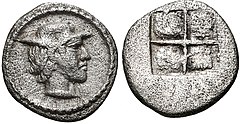
A petasos (Ancient Greek: πέτασος) or petasus (Latin) is a broad brimmed hat of Thessalian origin worn by ancient Greeks, Thracians and Etruscans, often in combination with the chlamys cape. It was made of wool felt, leather, straw or animal skin. Women's versions had a high crown while those for men featured a lower crown. It was worn primarily by farmers, travellers and hunters, and was considered characteristic of rural people. As a winged hat, it became the symbol of Hermes, the Greek mythological messenger god.
Along with the pileus, the petasos was the most common hat worn in Ancient Greece. Its wide brim protected the wearer from the sun and rain while a lengthy strap allowed wearers to secure it under the chin. Its popularity later extended to the Etruscans, the Byzantine Empire and the Roman Empire, in slightly modified forms.
A type of metal helmet worn by Athenian cavalry was made in the shape of a petasos. Some examples have holes around the outer edge of the brim, presumably so a fabric cover could be attached. These are known from reliefs and vase paintings, with at least one archaeological example found in an Athenian tomb.
Gallery
-
 Hermes wearing a petasos and bearing a caduceus
Hermes wearing a petasos and bearing a caduceus
-
 Views of a petasos
Views of a petasos
-
 Petasos-wearing youth with spear and leopardskin
Petasos-wearing youth with spear and leopardskin
-
 Young warrior with a cloak and petasos dangling over the back
Young warrior with a cloak and petasos dangling over the back
-
 Coin of Alexander I, struck circa 460-450 BC. Young male head right, wearing a petasos.
Coin of Alexander I, struck circa 460-450 BC. Young male head right, wearing a petasos.
-
 Coinage of Kapsa, Macedon, circa 400 BC.
Coinage of Kapsa, Macedon, circa 400 BC.
See also
References
- Bonfante, Larissa (2003-10-31). Etruscan Dress. JHU Press. ISBN 9780801874130.
- Britannica, The Editors of Encyclopaedia. "petasos". Encyclopedia Britannica, 26 Jul. 2010, https://www.britannica.com/topic/petasos . Accessed 29 November 2021.
- Sacks, David. "clothing, ancient Greek." Encyclopedia of the Ancient Greek World, David Sacks, Facts On File, 3rd edition, 2015. Credo Reference. Accessed 29 Nov. 2021.
- "Greek Headwear." Fashion, Costume, and Culture: Clothing, Headwear, Body Decorations, and Footwear Through the Ages, edited by Sara Pendergast, et al., 2nd ed., vol. 1: The Ancient World, UXL, 2013, pp. 127-134. Gale In Context: World History. Accessed 28 Nov. 2021.
- "Headwear of the Byzantine Empire." Fashion, Costume, and Culture: Clothing, Headwear, Body Decorations, and Footwear Through the Ages, edited by Sara Pendergast, et al., 2nd ed., vol. 2: Early Cultures Across the Globe, UXL, 2013, pp. 257-259. Gale In Context: World History. Accessed 28 Nov. 2021.
- Sekunda, Nicholas (2005) . The Ancient Greeks. Osprey. p. 19.
External links
 Media related to Petasos at Wikimedia Commons
Media related to Petasos at Wikimedia Commons
| Historical clothing | ||
|---|---|---|
| Clothing generally not worn today, except in historical settings | ||
| Body-length |  | |
| Tops | ||
| Trousers | ||
| Skirts | ||
| Dresses | ||
| Outerwear |
| |
| Underwear | ||
| Headwear |
| |
| Footwear | ||
| Accessories | ||